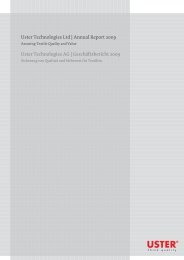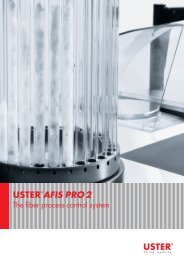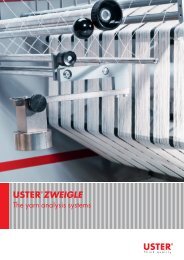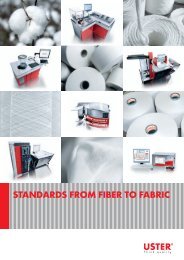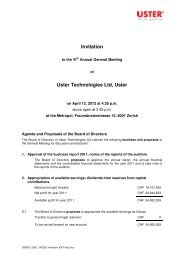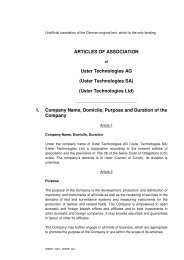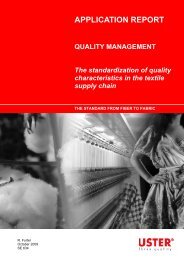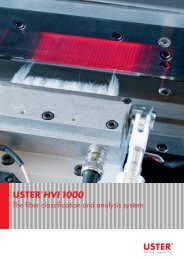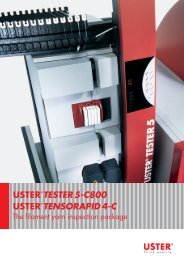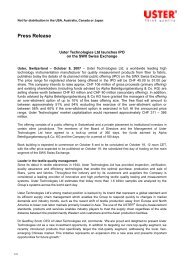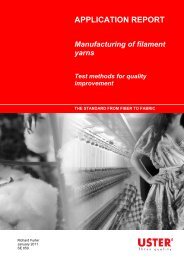Application Handbook_Uster_Statistics - Uster Technologies
Application Handbook_Uster_Statistics - Uster Technologies
Application Handbook_Uster_Statistics - Uster Technologies
- No tags were found...
You also want an ePaper? Increase the reach of your titles
YUMPU automatically turns print PDFs into web optimized ePapers that Google loves.
4.4 Roving TestingMass variation of the roving has a decisive influence on the yarn quality later on. Therefore, it isimportant to monitor the evenness of the roving regularly. The capacitive measuring system of theUSTER ® TESTER permits fast and reproducible measurements. Based on spectrograms anddiagrams, it is easy to eliminate the sources of defects in the same or previous processes.Characteristics Abbreviation Unit DescriptionCoefficient of variation of mass CV m % Coefficient of variation of the yarn mass (Fig. 4-4)Coefficient of variation of mass atdifferent cut lengthsCV m (L) % Coefficient of variation of the yarn mass at cut lengthsof 1 m, 3 m , 10 mTable 4-84.5 Yarn TestingPractical experience has proven time and time again that winding alters the yarn surface structure.The impact on yarn evenness (CVm) is very limited but changes in imperfection counts (thin places,thick places, and neps), hairiness (H), and standard deviation of hairiness (sH) are much morepronounced. Under normal circumstances, the tensile properties, i.e. tenacity, elongation, and workto-breakare not affected unless yarns are subjected to excessive winding tension or winding speeds,which is very rarely the case and certainly not a prudent practice. A clear statement must be madeconcerning the role of the winding machine: Changes in the yarn surface structure due to windingcannot be avoided. Nobody would honestly expect a yarn to become better after it has beenaccelerated from zero to 1500 m/min or more in a few milliseconds while being pulled off the bobbin,dragged across several deflection bars and eyelets, forced into a traverse motion at speeds that makeit invisible, and finally rolled up into a firm construction called package or cone. The factors that affectthe yarn structure during winding include the frictional properties of the yarn itself, the friction of thedrum, the bobbin geometry and the bobbin unwinding behavior, winding speed, winding geometry aswell as the number and design of the yarn/machine contact points. However, much as the bobbinunwinding behavior today is the limiting factor for winding speed, it is also the main reason for thesechanges in yarn structure. Most of the damage occurs at the moment when the end is detached andremoved from the tight assembly of yarn layers on the bobbin and dragged along the tube at very highspeeds.When testing 100% cotton yarns in cone form for evenness, imperfections, and hairiness with theUSTER ® TESTER, some very fine and delicate yarns will again respond with marginal structuralchanges. This is not a result of mechanical stress like in winding but a natural reaction caused by thereversal of the yarn running direction. Directional influences are omnipresent; they become apparentin all subsequent processing stages. The evidence of changes in the yarn surface structure due to thewinding process or as a result of reversing the yarn running direction is confined to a few very delicate100% man-made fiber yarns, core yarns, and 100% cotton yarns finer than Ne 60 (Nm 100, 10 tex).We recommend, however, that the USTER ® STATISTICS on 100% carded and combed cotton ringspunyarns on cross-wound packages be referred to whenever mass variation, hairiness, andimperfections of cotton yarns in cones form are of interest.Since the tensile properties are not affected by the phenomena described above, the USTER ®STATISTICS on ring-spun bobbins could be used for packages as well. The STATISTICS on countvariation and the between-sample coefficients of variation of evenness and hairiness are only usefulwhen testing bobbins.USTER ® STATISTICS 18 (36)



